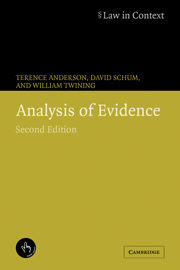Book contents
- Frontmatter
- Contents
- Preface
- Acknowledgments
- Tables of cases and statutes
- Table of legislation and rules
- List of abbreviations
- 1 Evidence and inference: some food for thought
- 2 Fact investigation and the nature of evidence
- 3 Principles of proof
- 4 Methods of analysis
- 5 The chart method
- 6 Outlines, chronologies, and narrative
- 7 Analyzing the decided case: anatomy of a cause célèbre
- 8 Evaluating evidence
- 9 Probabilities, weight, and probative force
- 10 Necessary but dangerous: generalizations and stories in argumentation about facts
- 11 The principles of proof and the law of evidence
- 12 The trial lawyer's standpoint
- Glossary of terms and symbols
- References
- Index
9 - Probabilities, weight, and probative force
Published online by Cambridge University Press: 23 November 2009
- Frontmatter
- Contents
- Preface
- Acknowledgments
- Tables of cases and statutes
- Table of legislation and rules
- List of abbreviations
- 1 Evidence and inference: some food for thought
- 2 Fact investigation and the nature of evidence
- 3 Principles of proof
- 4 Methods of analysis
- 5 The chart method
- 6 Outlines, chronologies, and narrative
- 7 Analyzing the decided case: anatomy of a cause célèbre
- 8 Evaluating evidence
- 9 Probabilities, weight, and probative force
- 10 Necessary but dangerous: generalizations and stories in argumentation about facts
- 11 The principles of proof and the law of evidence
- 12 The trial lawyer's standpoint
- Glossary of terms and symbols
- References
- Index
Summary
Introduction
There are no conclusions reached in legal disputes that can be stated with absolute certainty. Consequently, the use of probabilistic concepts is as common in inferences in law as it is in inferences in other contexts. Probabilistic judgments concerning various matters in law are usually made verbally. For example, forensic standards of proof involve verbal probabilistic hedges such as “beyond reasonable doubt,” “clear and convincing evidence,” and “probable cause.” In some contexts it is supposed that probabilistic judgments will always be stated numerically either using numbers on the conventional zero-one probability scale or in terms of odds. But in other contexts, lawfor example, such numerical judgments are quite difficult to make and justify because the events of concern either happened or did not happen on exactly one occasion. We cannot play the world over again a thousand times to determine the frequency with which these events have happened in the past. On only rare occasions in law can probabilities be determined by counting the frequency with which some event has occurred in the past.
There are basically five reasons why, in any context including law, conclusions based on evidence are necessarily probabilistic in nature. The first is that our evidence is always incomplete, we never have all of it. The second is that evidence is commonly inconclusive. This means that the evidence may to some degree favor more than one proposition at issue to some extent, or be consistent with the truth of more than one proposition at issue.
- Type
- Chapter
- Information
- Analysis of Evidence , pp. 246 - 261Publisher: Cambridge University PressPrint publication year: 2005



